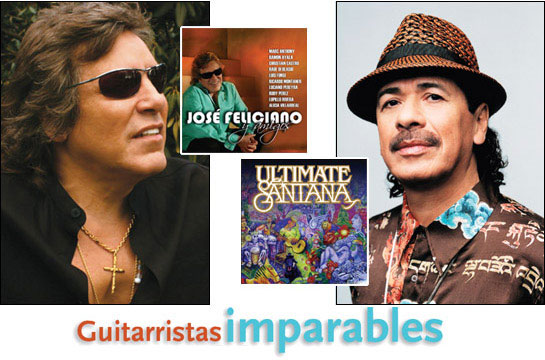
JOSÉ FELICIANO
At 61 years young, José Feliciano has a lot going on. Born blind to a struggling family in Puerto Rico, the odds were against him, but Feliciano picked up the accordion at age seven, learning by ear from the few records he owned. At nine, he decided to play the guitar. Practicing as much as 14 hours a day, Feliciano mastered his skill as a guitarist, and he hit the coffeehouse circuit in his late teens. In 1966, RCA scouts heard him play at the Mar De Plata festival in Argentina. Impressed with his talent, they signed him right then. Feliciano’s first three albums were in Spanish, and Feliciano found his niche by taking old bolero songs he heard as a kid and putting his own unique, modern twist on them, instantly generating hits. Convinced it was time for an English-language hit, producer Rick Jarrad thought Feliciano should record his version of the Doors’ “Light My Fire.” It was a smash hit and became the best known cover of that song. Securing another place in history, Feliciano wrote and recorded what is now a Christmas classic, “Feliz Navidad.”
In 1968, Feliciano was the first artist to publicly perform his own version of the “Star Spangled Banner”—quite controversial at the time—but it became a Top 40 hit, equally unusual for a National Anthem. Another first for Feliciano was crossing over from Latin music to American pop. Besides performing, Feliciano wrote steadily (he and wife Susan penned the songs for the play The Ice Cream Suit), acted in TV shows, and hosted his own Connecticut radio show.
Known for his humanitarian projects (a school in East Harlem is named after him), today Feliciano is working on a new album and staying close to his family, a high priority in his life. Still, he tours regularly, and in 2007 released two new albums: José Feliciano y Amigos, an all-Spanish duet album with contributions from some of the top Latin artists such as Rudy Perez and Marc Anthony, as well as the intimate The Soundtrax of My Life, which is Feliciano’s most personal album to date. Although nearing retirement age, that word is not in Feliciano’s vocabulary at this time.
CARLOS SANTANA
Born in Autlan de Navarro, Mexico, Carlos Santana, son of a Mariachi violinist, followed his father’s musical bent and picked up a violin at five. When his family moved to Tijuana, Carlos, then eight, turned to the guitar, and ultimately launched a new branch of American music.
Initially emulating blues icons like John Lee Hooker and B.B. King, Santana honed his chops. In 1961 the Santana family moved to San Francisco where, after graduating from high school in 1966, Carlos formed the Santana Blues Band. The band fused his early blues influences with the rhythms of his Latin roots. By the end of the ’60s, Santana the man and Santana the band carved out a significant role in the defining San Francisco music scene, and by June 1968 were playing Bill Graham’s Fillmore West. In September, Santana joined Al Kooper for a follow-up to the Kooper/Mike Bloomfield/Steven Stills Super Session album, and made his recording debut with The Live Adventures of Mike Bloomfield and Al Kooper.
The original group broke up, but Carlos retained rights to the name, and the band—now called simply “Santana”—consisted of Carlos and constantly changing sidemen. He recorded a live show with drummer Buddy Miles, Carlos Santana & Buddy Miles! Live! (1972), which reached the Top Ten and eventually went platinum.
Santana released a series of gold or platinum albums nearly every year between 1972 and 1987, and won a Grammy for Best Rock Instrumental Performance (1987), but then spent almost five years away from recording, returning in June 1999 with Supernatural. Featuring many tracks co-written by guest stars such as Rob Thomas of Matchbox Twenty and Eric Clapton, the album became his biggest hit to date, selling about ten million copies and winning eight Grammys.
Santana’s fall project, Ultimate Santana, is some 17 cuts confirming the amazing scope of this artist, from his earliest years on Columbia Records and Arista into the 21st century. Three previously unreleased tracks, including collaborations with Nickelback’s Chad Kroeger and Tina Turner, put the cherry on the cake. E
![]()
Elmore: What are you listening to right now?
José Feliciano: Maroon 5, Nickelback and Jack’s Mannequin
Carlos Santana: Manitas de Plata. He’s the John Lee Hooker of Flamenco.
EM: What was the first record you ever bought?
JF: There were two, “Goodnight Sweetheart, Goodnight,” by the McGuire Sisters, or “Tell Me A Story,” by Jimmy Boyd and Frankie Laine.
CS: The Best of Little Walter
EM: Where do you buy your music?
JF: I used to buy it at Sam Goody’s when I lived in New York City, but now I don’t buy much music, I go to iTunes. Sad to say, I think the recording industry brought this situation on itself. I don’t buy many CDs anymore.
CS: I do a little Borders now that Tower Records is gone, and I’m trying to go more on the websites.
EM: What are your favorite albums of all time?
JF: Sergeant Pepper. I’m a huge Beatles fan. My favorite country steel guitar solo was the Jerry Garcia solo on “Teach Your Children” by Crosby, Stills and Nash.
CS: There’s nothing more contagious than a spiritual virus. That’s why I love Coltrane and Bob Marley, it’s holy, sacred, wholesome. There are big slices of life in every note.
EM: What was the first instrument you played?
JF: I played an empty Saltines box, then harmonica; then accordion at seven, and took up the ukulele at eight, then the guitar at nine, given to me by a friend of the family, a $10 Stella.
CS: Violin at five. My father had me at it for a long time. I don’t play it now, I can’t stand it.
EM: What brought you to the instrument you now play?
JF: I heard Andrés Segovia play, and heard the sound and what could be done with the guitar.
CS: I was playing bass first, but they told me I was playing too many notes on the bass. I immediately took to the guitar.
EM: What musician influenced you most?
JF: Andrés Segovia, certainly. Django Reinhardt, Wes Montgomery, Johnny Smith, a jazz guitarist. In bluegrass, Earl Scruggs and Chet Atkins.
CS: My father.
EM: What was the song or event that made you realize you wanted to be in music?
JF: I would sit in front of the TV and figured if I could play along with American Bandstand, or the radio, I could be a musician. I received a lot of applause at school assemblies, and that gave me the idea. The teachers used to say, “Don’t rile them up too much.” By 18 or 19, I was playing the coffeehouse circuit across the country.
CS: When I saw my father serenading my mom, after they had a fallout. He came, and two blocks away, I could hear him singing and playing the violin. It was a beautiful melody, “Veriza Tropical” which means “tropical past.” It goes something like this: [sings] “doo do…” It’s that romantic music that makes all women melt like Mozzarella cheese. When you combine the blues with Cape Verde music, the women don’t stand a chance.
EM: Who would you like in your rock and roll heaven band?
JF: If it were a rock band, I’d have Sting on bass, or Ray Brown on upright bass. For me he’s the king of the upright bass, he was from another planet. Ginger Baker on drums, me on electric guitar, but also maybe Jimi Hendrix. Billy Preston on keyboards or Ray Charles. Dizzy Gillespie, Charlie Parker on sax, and Tommy Dorsey on trombone.
CS: Two guitar players, Jimi Hendrix and Stevie Ray. And two bass players, Jaco (Pastorius) and Larry Graham. Two drummers, Elvin Jones and Tony Williams. Larry Young on Hammond organ, and Keith Jarrett on piano, and just to anchor the whole thing? Otis Spann! Keep the low side of the piano, just rumbling.
EM: What’s your desert island CD?
JF: Either Sergeant Pepper, or Highway 61 Revisited. I always had good communication with Bob Dylan.
CS: Sketches of Spain—Miles Davis, and A Love Supreme—John Coltrane.


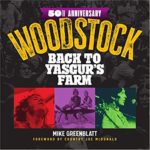
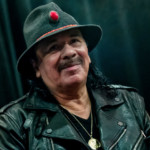
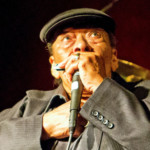
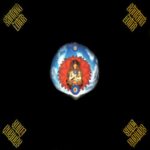

Great Jose Feliciano!
Underrated genius!!